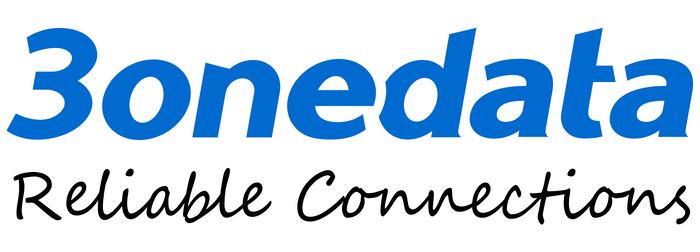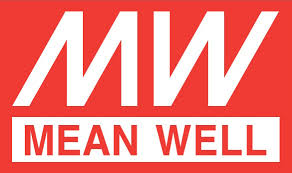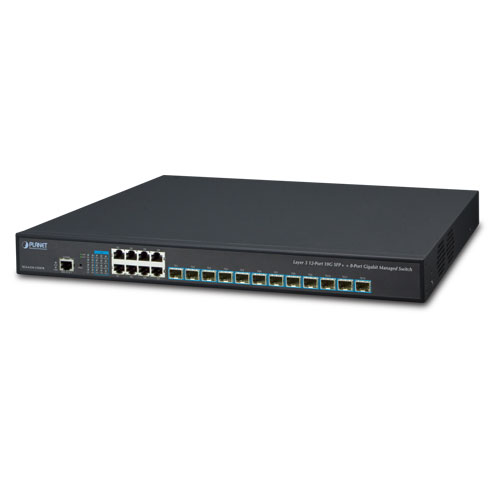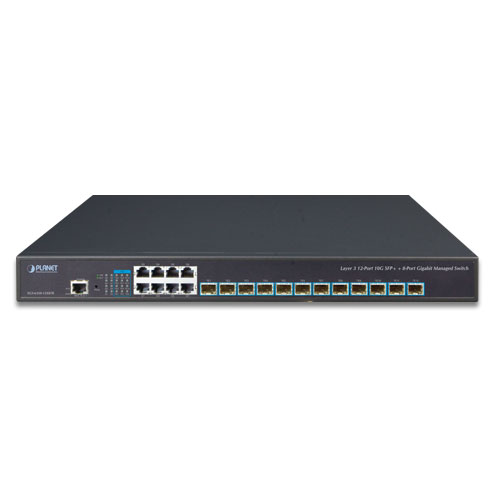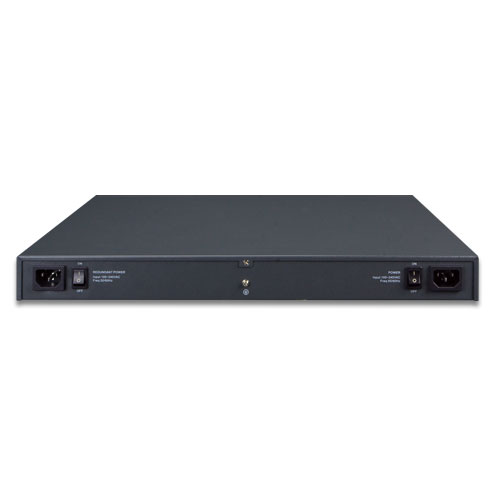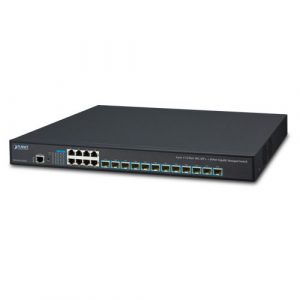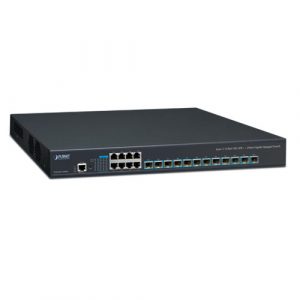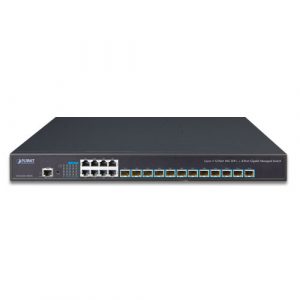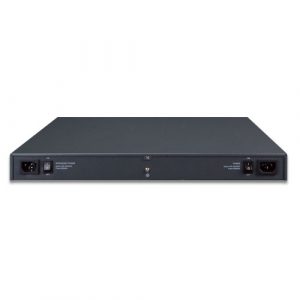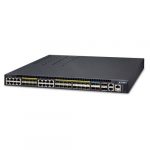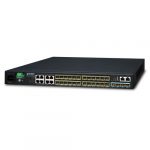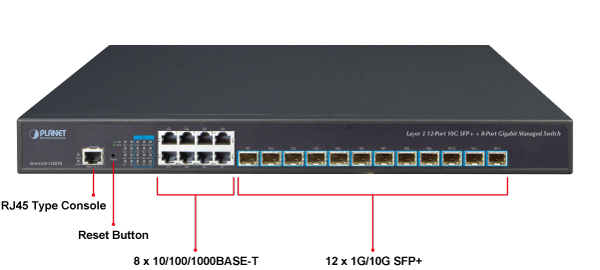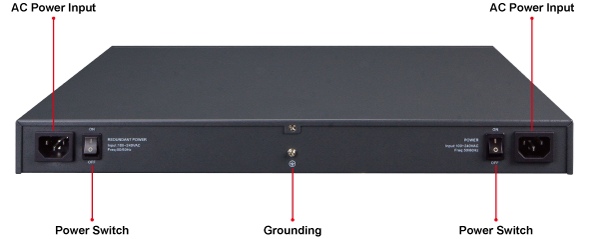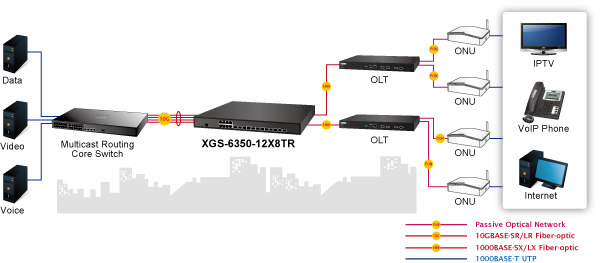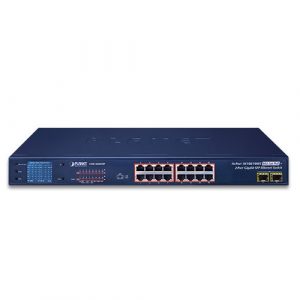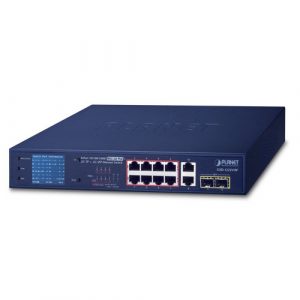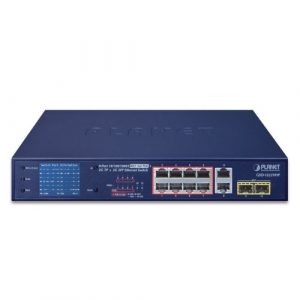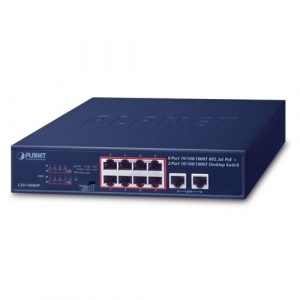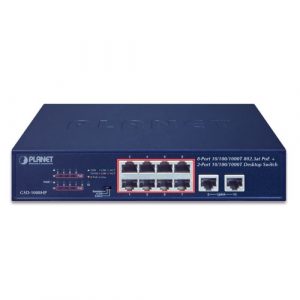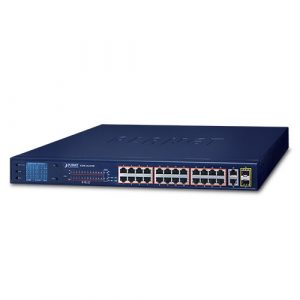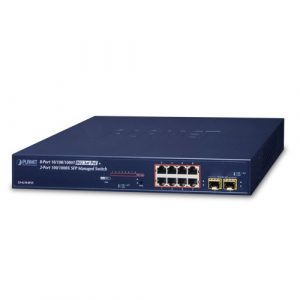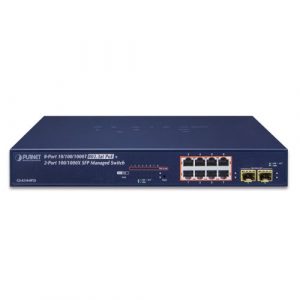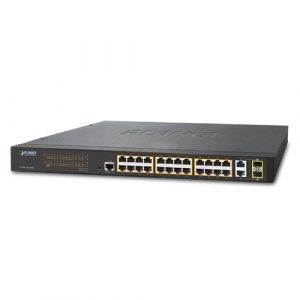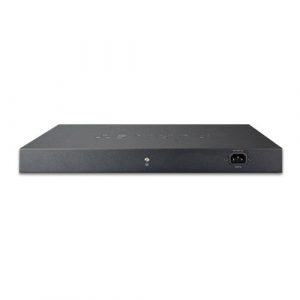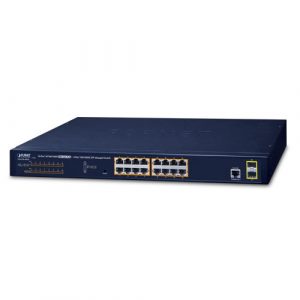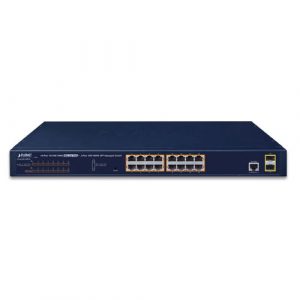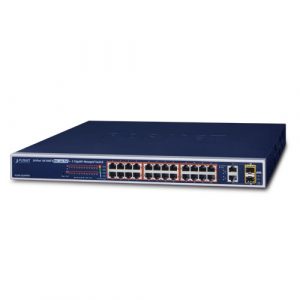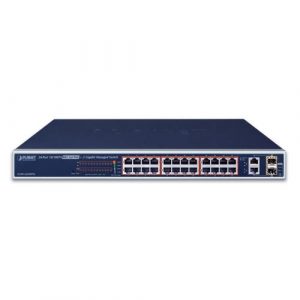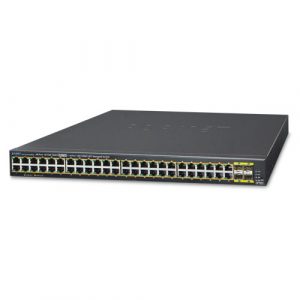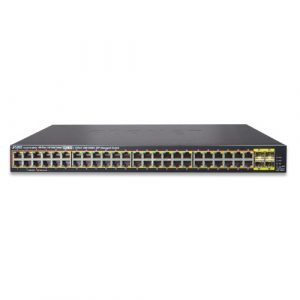XGS-6350-12X8TR
Layer 3, 12-Porte 10G SFP+8-Porte 10/100/1000T +1 X RJ45 Type Console + Stackable Management Gigabit Switch With Dual 100-240V AC, Redundant Power Included (inclusi 2 alimentatori interni)
- Applicazioni
- SPECIFICHE
- DOWNLOAD
Descrizione
Potente soluzione da 10 Gbps per tutte le reti a lunga portata
PLANET XGS-6350-12X8TR è uno switch Gigabit gestito Layer 3 che fornisce prestazioni ad alta densità grazie al routing Layer 3 10 Gigabit con 12 interfacce in fibra SFP+ e 8 interfacce Gigabit fornite in una custodia robusta. L’amministratore può scegliere in modo flessibile il transceiver SFP/SFP+ adatto in base alla distanza di trasmissione o alla velocità di trasmissione richiesta per estendere in modo efficiente la rete 10G. Inoltre, con la struttura di commutazione da 176 Gbps, XGS-6350-12X8TR può gestire quantità di dati estremamente elevate in una topologia sicura che si collega a server backbone o ad alta capacità per aziende, data center, campus e così via dove vengono utilizzate applicazioni VoIP, streaming video e multicast.
Doppia alimentazione AC ridondante per garantire un funzionamento continuo
XGS-6350-12X8TR è dotato di due unità di alimentazione AC da 100~240 V per l’installazione di un’alimentazione ridondante. Viene inoltre fornito un sistema di alimentazione ridondante per migliorare l’affidabilità con due unità di alimentazione AC. Il sistema di alimentazione ridondante è specificamente progettato per gestire le esigenze di strutture ad alta tecnologia che richiedono la massima integrità di alimentazione.
Supporto di routing Layer 3
XGS-6350-12X8TR consente all’amministratore di aumentare comodamente l’efficienza della rete configurando manualmente il routing statico Layer 3, le impostazioni RIP (Routing Information Protocol) o OSPF (Open Shortest Path First) automaticamente. Il RIP può utilizzare il conteggio dei salti come metrica di routing e prevenire loop di routing implementando un limite al numero di salti consentiti in un percorso dalla sorgente alla destinazione. L’OSPF è un protocollo di routing dinamico interno per sistemi autonomi basato sullo stato dei collegamenti. Il protocollo crea un database dello stato dei collegamenti scambiando gli stati dei collegamenti tra gli switch Layer 3, quindi utilizza l’algoritmo Shortest Path First per generare una tabella di routing basata su tale database.
Soluzione di rete mesh ad alta disponibilità per sistemi Big Data
Grazie al miglioramento della tecnologia di Ethernet in fibra ottica con funzionalità altamente flessibili, altamente estensibili e facili da installare, XGS-6350-12X8TR offre una velocità di scambio dati fino a 256 Gbps tramite interfaccia in fibra ottica e la distanza di trasmissione può essere estesa a 120 km (fibra monomodale). XGS-6350-12X8TR è dotato di una forte capacità di autoripristino rapido per prevenire interruzioni e intrusioni esterne. Incorpora il protocollo Multiple Spanning Tree (802.1s MSTP) nella rete di automazione del cliente per migliorare l’affidabilità e i tempi di attività del sistema. XGS-6350-12X8TR è la soluzione ideale per data center, fornitori di servizi e telecomunicazioni per creare connessioni ridondanti e stabilire un’elevata larghezza di banda per la server farm Big Data.
Servizio Triple Play di Backbone Network Solution
Nelle telecomunicazioni, il servizio triple play è un termine di marketing per la fornitura su una singola connessione a banda larga di servizi che richiedono più larghezza di banda, come l’accesso a Internet a banda larga, la televisione e il telefono sensibile alla latenza. L’XGS-6350-12X8TR fornisce fino a 256 Gbps di larghezza di banda per scambiare pacchetti di dati, voce e video tramite cavo patch in fibra. È lo switch di aggregazione adatto per ISP e Telco che costruiscono un’infrastruttura di rete backbone a traffico pesante.
Routing VLAN Layer 3 e applicazione uplink 10G
Con i robusti protocolli di routing Layer 3 integrati, XGS-6350-12X8TR garantisce un routing affidabile tra VLAN e segmenti di rete. I protocolli di routing possono essere applicati tramite interfaccia VLAN con un massimo di 128 voci di routing. XGS-6350-12X8TR, la soluzione ideale per le aziende, offre maggiore sicurezza, controllo e conservazione della larghezza di banda e uplink ad alta velocità
| Hardware Specifications | |
|---|---|
| Ethernet Ports | 8 1000BASE-T RJ45 auto-MDI/MDI-X ports |
| SFP+ Slots | 12 10GBASE-SR/LR SFP+ interface Compatible with 1000BASE-SX/LX/BX SFP transceiver |
| Console | 1 x RJ45-to-DB9 serial port (9600, 8, N, 1) |
| Reset Button | Reset to factory default |
| Switch Architecture | Store-and-forward |
| Switch Fabric | 256Gbps/non-blocking |
| Switch Throughput | 180Mpps |
| Address Table | 32K MAC address table with auto learning function |
| Shared Data Buffer | 3MB |
| Flow Control | Back pressure for half duplex IEEE 802.3x pause frame for full duplex |
| Jumbo Frame | 9KB |
| LED |
System: PWR, SYSPorts: 10/100/1000T RJ45 Port: LNK/ACT 1/10G SFP+ Slot: LNK/ACT |
| Dimensions (W x D x H) | 442.5 x 315 x 44 mm, 1U height |
| Weight | 4178g |
| Power Consumption | 55 watts/187.66 BTU (maximum) |
| Power Requirements | AC 100~240V, 50/60Hz |
| Fan | 2 |
| Management Function | |
| System Configuration | Console, Telnet, SSH, Web browser, SNMP v1, v2c and v3 |
| Management | Supports both IPv4 and IPv6 addressing Supports the user IP security inspection for IPv4/IPv6 SNMP Supports MIB and TRAP Supports IPv4/IPv6 TFTP Supports IPv4/IPv6 NTP Supports RMON 1, 2, 3, 9 groups Supports the RADIUS authentication for IPv4/IPv6 Telnet user name and password Supports IPv4/IPv6 SSH The right configuration for users to adopt RADIUS server’s shell management Supports CLI, console, Telnet Supports SNMPv1, v2c and v3 Supports Security IP safety net management function: avoid unlawful landing at non-restrictive area Supports Syslog server for IPv4 and IPv6 Supports TACACS+ |
| Layer 3 Function | |
| Routing Protocol | Static routing, RIP and OSPF |
| Routing Table | 128 |
| DHCP | DHCP client DHCP server, default-route |
| VRRP | Configure VRRP in interface VLAN; VRRP priority; VRRP standby; VRRP track |
| Load Balancing | Use of equivalent routing, the correct load balancing function (by flow) |
| Layer 2 Function | |
| Port Configuration | Port disable/enable Auto-negotiation 10/100/1000Mbps full and half duplex mode selection Flow control disable/enable Bandwidth control on each port Port loopback detect |
| Port Status | Display each port’s speed duplex mode, link status, flow control status and auto negotiation status |
| VLAN | 802.1Q tag-based VLAN, up to 4K VLAN entries 802.1ad Q-in-Q (VLAN stacking) GVRP for VLAN management Private VLAN Edge (PVE) supported Protocol-based VLAN MAC-based VLAN IP subnet VLAN |
| Bandwidth Control | TX/RX/both |
| Link Aggregation | IEEE 802.3ad LACP/static trunk Supports 32 groups with 8 ports per trunk group |
| QoS | 8 priority queues on all switch ports Supports strict priority and Weighted Round Robin (WRR) CoS policies Traffic classification: – IEEE 802.1p CoS/ToS – IPv4/IPv6 DSCP – Port-based WRR |
| Multicast | IGMP v1/v2/v3 snooping Querier mode support MLD v1/v2 snooping Querier mode support Multicast VLAN Register (MVR) |
| Access Control List | Supports Standard and Expanded ACL IP-based ACL/MAC-based ACL Time-based ACL Up to 1K entries |
| Bandwidth Control | At least 64Kbps stream |
| Security | Port isolation Supports IP + MAC + port binding Identification and filtering of L2/L3/L4 based ACL Defend against DOS or TCP attacks Suppression of broadcast, multicast and unknown unicast packet DHCP Snooping, DHCP Option 82 Command line authority control based on user levels |
| Authentication | IEEE 802.1x port-based network access control AAA authentication: TACACS+ and IPv4/IPv6 over RADIUS |
| SNMP MIBs | RFC 1213 MIB-II RFC 1215 Internet Engineering Task Force RFC 1271 RMON RFC 1354 IP-Forwarding MIB RFC 1493 Bridge MIB RFC 1643 Ether-like MIB RFC 1907 SNMPv2 RFC 2011 IP/ICMP MIB RFC 2012 TCP MIB RFC 2013 UDP MIB RFC 2096 IP forward MIB RFC 2233 if MIB RFC 2452 TCP6 MIB RFC 2454 UDP6 MIB RFC 2465 IPv6 MIB RFC 2466 ICMP6 MIB RFC 2573 SNMPv3 notification RFC 2574 SNMPv3 VACM RFC 2674 Bridge MIB Extensions |
| Standard Conformance | |
| Regulatory Compliance | FCC Part 15 Class A, CE |
| Standards Compliance | IEEE 802.3 10BASE-T IEEE 802.3u 100BASE-TX IEEE 802.3z Gigabit 1000BASE-SX/LX IEEE 802.3ab Gigabit 1000BASE-T IEEE 802.3ae 10Gb/s Ethernet IEEE 802.3x flow control and back pressure IEEE 802.3ad port trunk with LACP IEEE 802.1D Spanning Tree Protocol IEEE 802.1w Rapid Spanning Tree Protocol IEEE 802.1s Multiple Spanning Tree Protocol IEEE 802.1p Class of Service IEEE 802.1Q VLAN tagging IEEE 802.1X port authentication network control IEEE 802.1ab LLDP RFC 768 UDP RFC 793 TFTP RFC 791 IP RFC 792 ICMP RFC 2068 HTTP RFC 1112 IGMP v1 RFC 2236 IGMP v2 RFC 3376 IGMP v3 RFC 2710 MLD v1 FRC 3810 MLD v2 RFC 2328 OSPF v2 RFC 1058 RIP v1 RFC 2453 RIP v2 |
| Environment | |
| Operating | Temperature: 0 ~ 60 degrees C Relative Humidity: 10 ~ 85% (non-condensing) |
| Storage | Temperature: -40 ~ 80 degrees C Relative Humidity: 5 ~ 95% (non-condensing) |


